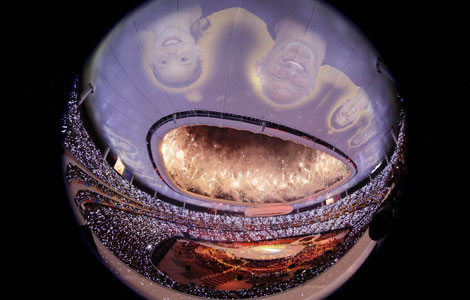Part of Great Wall collapses amid mining
Updated: 2011-10-19 14:59
(Xinhua)
|
|||||||||||
SHIJIAZHUANG - Unregulated mining has caused part of China's ancient Great Wall to collapse, sounding an alarm for protecting one of the country's signature relics as well as a UNESCO World Cultural Heritage site.
The damaged portion of the Great Wall is located in a remote area near the county of Laiyuan in Hebei Province, about 200 kilometers southwest of Beijing. The area is home to a dozen small mines, with some operating as close as 100 meters to the centuries-old wall.
Villagers and local cultural heritage protection officials told Xinhua that about 700 meters of the wall, which was built during the reign of Emperor Wanli during the Ming Dynasty (1573-1620), had already collapsed, and more walls and even towers are likely to collapse if the mining continues unchecked.
"This section of the wall is considered 'the crust of the cream' of the Ming Dynasty Great Wall. It is really a pity," said Guo Jianyong, a senior engineer with the provincial Ancient Architecture Studies Institute.
Construction of the first Great Wall dates back to the Warring States Period (475-221 BC) and, over subsequent centuries, walls were built in scattered, but strategic areas to defend against the invasions of northern nomadic tribes, historical data show.
Today, remnants of the Great Wall, mostly built during the Ming Dynasty, stretch over 6,700 kilometers from west to northeast China, spanning the provinces and regions of Hebei, Tianjin, Beijing, Shanxi, Inner Mongolia, Shaanxi, Ningxia, and Gansu.
Damage to the Great Wall by mining had previously been reported in recent years in Inner Mongolia, China's main coal reserve region, but the Hebei case suggests the problem might be common across all regions, experts say.
In Hebei, about 20 percent of the walls and towers can be rated "well or fairly preserved," while more than 70 percent have cracks, stand on shaky ground, or are about to collapse, provincial cultural protection officials said.
Zhou Jinjun, a deputy head of Laiyuan's land resources bureau, said the area where the ancient walls stand in Laiyuan has rich reserves of copper, iron, and nickel. Driven by profits, small mines proliferated despite the government ban.
A part of the Great Wall in Hebei's Chongli County was even demolished by a mining company to make way for road construction.
Zhou said law enforcement officials have found it difficult to completely stamp out small mines as mine bosses are armed with advanced communication equipment, helping them dodge law enforcement.
The State Council enacted a regulation to protect the Great Wall in 2006, banning people from taking soil or bricks from the wall, planting trees, carving on the wall or building anything that does not protect it. But experts and cultural heritage officials said the bans are poorly enforced in remote regions.
Guo said miners in Laiyuan did not knock down the walls, but mining at such a close range to the walls poses more serious threats.
"We don't know how much of the underground area near the walls has become hollow. The impact to the walls is unpredictable," he said.
Guo said the cultural heritage bureau tasked to enforce the protection rules are low on funds, and short of enough employees and equipment to conduct effective monitoring of irregularities on and around the Great Wall.
In Laiyuan, the Great Wall stretches 123 kilometers, but the county only has an enforcement team of seven. Most of the 40 counties where the Great Wall stands in Hebei face the same problem, Guo said, adding that regulation enforcers in some counties are only able to conduct an inspection tour once a year.
Hot Topics
Libya conflict, Gaddafi, Oil spill, Palace Museum scandal, Inflation, Japan's new PM, Trapped miners, Mooncake tax, Weekly photos, Hurricane Irene
Editor's Picks

|

|

|

|

|

|







